12-1: Elvis Presley and Alf Landon
(a) No; those with more passionate views of Elvis are more likely to pay to voice their opinions.
(b) One flaw is that those with telephones or vehicles in 1936 tended to be the more affluent segment of society. Another flaw is that those who took the time to respond probably tended to be less satisfied with the incumbent.
(c) Elvis: population - all American adults, sample - those radio listeners who chose to pay to call in station
Literary Digest: population - all American adults, sample - those who received the questionnaire and chose to respond
(a) Gender: categorical (binary)
Party: categorical (binary)
State: categorical
Years of service: measurement
(b) - (e) These answers vary from student to student.
(f) no; no; almost certainly no
(g) No, the random sampling method is not biased because it does not systematically under- or over-represent certain groups.
(h) You would have to use three-digit labels for the representatives, read off three digits at a time from the table, and ignore numbers from 436 to 999 and 000.
(i)
12-3: Sampling U.S. Senators ( cont. )
(a) - (f) Answers vary.
(h) sample size of 10
(i) sample size of 40
(j) the population proportion of .47
(j) no
![]()
13-1: Colors of Reese's Pieces Candies
(a) Answers vary.
(b) statistic, ![]()
(c) parameter, ![]()
(d) no
(e) yes, answers vary.
(f) no; sampling variability
(g) Answers vary.
(h) no (almost surely)
(i) no (almost surely)
(j) Answers vary.
(k) yes; yes;
(l) more spread out
(m) less spread out
13-2: Simulating Reese's Pieces
(a) Answers vary.
(b) Distribution of sample proportion should be roughly mound shaped, symmetric, and centered in the neighborhood of 0.45.
(c) Answers vary.
(d) yes
(e) Answers vary.
(f) This should be the middle percentage from the table.
(g) no; yes; Since most (about 95%) sample proportions fall within .20 of the population proportion, it is quite likely that a particular sample proportion will fall within .20 of the population proportion.
(h) Answers vary.
(i) less spread out but roughly same shape and center
(j) Answers vary.
(k) There should be a higher percentage of sample proportions falling within ±.10 of .45 with samples of 75.
(l) larger sample size
(m) - (n) Answers vary.
(o) 95%
(p) Mean: .45; Standard deviation: .0995
(q) Mean: .45; Standard deviation: .0574
![]()
(a) parameter; ![]()
(b) ![]() =4/15
=4/15
(c) yes
(d) no; sampling variability
(e) - (g) Answers vary.
(h) no (almost surely)
(i) - (j) Answers vary.
(k) no
(l) - (m) Answers vary.
(n) no
(o) no
14-2: Widget Manufacturing ( cont. )
(a) Answers vary.
(b) yes
(c) Answers vary. The evidence of improvement is even stronger here.
(a) 0
(b) 4797; 47.97%
(c) According to the simulation, the chance of getting nine or more correct by guessing is around 32.09%, not very surprising.
(d) According to the simulation, the chances of getting twelve or more correct is around 5.05%, moderately surprising.
(e) According to the simulation, the chances of getting fifteen or more correct is around .24%, very surprising.
(f) Only about 3 of every 10,000 subjects would get seventeen or more correct by guessing. This constitutes strong evidence that the person actually possesses some special ability.
![]()
15-1: Placement Scores and Reese's Pieces
(a) roughly symmetric, mound shaped
(b)

(c)
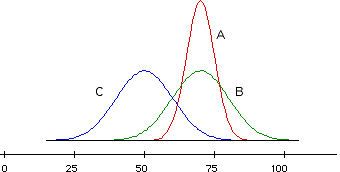
15-2: Standard Normal Calculations
(a) .7517
(b) .7517
(c) .2483
(d) .0838
(e) .6679
(f) less than .0002
(g) k = 1.28
(h) k = 1.53
(a) (Asks for prediction)
(b) -1.00
(c)
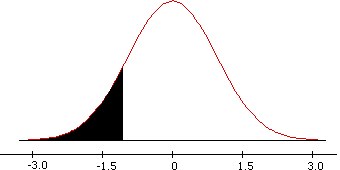
(d) .1587
(e) .9332
(f) .5007
(g) 0.1%
(h) 139.96
![]()
16-1: Sampling Reese's Pieces ( cont. )
(a) normal distribution with mean .45 and standard deviation .0574
(b)
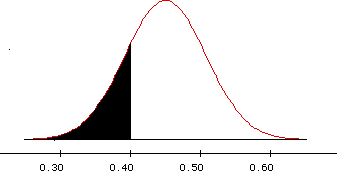
(c) .1922
(d) .9182
(e) They should be close.
(a) normal distribution with mean .25 and standard deviation .0791
(b)
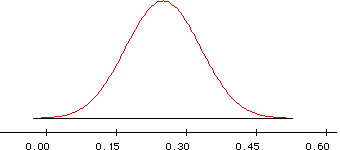
(c)
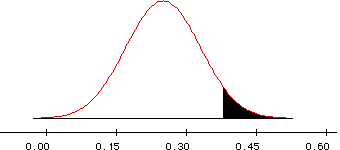
(d) .0505
(e) 12 or more correct: 505/10000. They are amazingly close.
(f) Reasonably but not terribly surprising; yes; no
(a) normal distribution with mean .45 and standard deviation .0376; same shape and center but less spread out
(b)
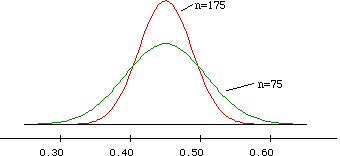
(c)
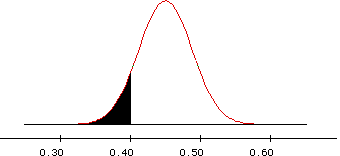
(d) .0918; smaller probability
(e) .9922; larger probability
![]()